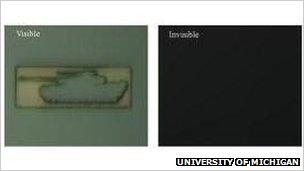Carbon nanotube 'space camouflage' coating invented
- Published

A tank etched out of silicon viewed without carbon nanotube coating (left) and with the coating
Tiny carbon tubes can be used to hide three-dimensional objects from view, according to a team of researchers.
The nanotubes are one-atom thick sheets of graphene wrapped into cylindrical tubes.
Engineers from University of Michigan found they could be used to obscure objects so that they appeared to be nothing more than a flat black sheet.
The team suggest "forests" of the material may one day be used to cloak spacecraft in deep space.
The group says the technology works because the nanotubes' "index of refraction [is] very close to that of air".
This means they slow down light to a similar degree.
As a result there is very little scattering of light as it passes from the air into the layer of nanotubes.
Hidden tank
Haofei Shi, the report's lead author, said the material "acts as a perfect black cloth that can completely conceal the 3D structure of the object".
To put his theory to the test his team etched a tiny 3D image of a tank out of silicon.
When viewed through a microscope the tank's contours could be clearly seen under white light.
However, when the nanotube coating was applied the tank's structure disappeared and could not be distinguished from the background.
The research will be published in an issue of the Applied Physics Letters journal.
The group is not the first to suggest carbon nanotubes could be used to create an invisibility cloak.
A scientist at the University of Texas at Dallas recently demonstrated, external that transparent sheets of the material, which looked like threads, vanished from view when placed in a liquid and were heated.
Dr Ali Aliev said the material created a mirage effect, causing light to bend around it.
He likened the effect to "puddles of water" that seem to appear on road surfaces when viewed from a distance on a hot day.
Dr Aliev suggested the material might one day be scaled up to hide large objects including military vehicles.
Other planets
Carbon nanotubes' light absorbing properties are also the focus of research at Nasa.
The space agency revealed earlier this year, external that it was studying using the substance to create a new kind of black paint.
The coating can absorb more than 99% of visible, ultraviolet, infrared and near-infrared light.
Nasa suggested it could be used in detectors and instrument components where stray-light causes problems.
Since the material reflects hundreds of times less light than the paints currently used, the agency said it could help create equipment capable of measuring distant objects such as planets orbiting stars outside our solar system.
"This is a very promising material," Nasa scientist Ed Wollack said.
"It's robust, lightweight, and extremely black. It is better than black paint by a shot."
- Published14 October 2011
- Published26 September 2011